Computer Vision and Machine Learning Methods for Heat Transfer and Fluid Flow in Complex Structural Microchannels: A Review
Abstract
:1. Introduction
2. Monitoring Methods by Visualization
2.1. Visualization of Flow Patterns
2.2. High-Speed Visualization of Different Microchannel Structures
2.2.1. Microchannels with Increasing Heat Transfer Area
2.2.2. Microchannels with Micro Structures
2.2.3. Other Microchannels
2.3. Visual Study on the Surface Wettability of Microchannels
2.4. Application of Computer Vision Technology
3. Application of Machine Learning in Microchannel Flow Pattern Recognition
3.1. Intelligent Flow Pattern Identification Process Based on Machine Learning
3.2. Application of Machine Learning for Flow Pattern Recognition
3.2.1. Application of Machine Learning to Flow Pattern Image Segmentation and Recognition in Microchannels
3.2.2. Application of Machine Learning for Flow Pattern Identification and Parameter Prediction in Microchannels
3.2.3. Application of SVM for Flow Pattern and Texture Feature Recognition in Microchannels
3.3. Application of Machine Learning for Boiling Flow Pattern Recognition in Microchannels
4. Discussion and Outlook
5. Conclusions
Author Contributions
Funding
Data Availability Statement
Conflicts of Interest
Abbreviations
| AI | Artificial intelligence |
| ANFIS | Adaptive neuro-fuzzy inference system |
| ANN | Artificial neural network |
| AR | Aspect ratio |
| BCF | Bidirectional counter-flow |
| BHT | Boiling heat transfer |
| BPNN | Back Propagation Neural Network |
| CBT | Convective boiling heat transfer |
| CCD | Charge-coupled device |
| CHF | Critical heat flux |
| CMC | Carboxymethyl cellulose |
| CNN | Convolutional neural network |
| D-D | Data-driven |
| DNN | Deep neural network |
| DL | Deep learning |
| ECVT | Electrical Capacitance Volume Tomography |
| GA-BP | Genetic Algorithm optimized Back Propagation |
| HPI | Hydrophilic |
| IM | Interconnected microchannels |
| IR | Infrared |
| KNN | K-nearest neighbor |
| LFDM | Laser confocal displacement meter |
| LSTM | Long short-term memory |
| ONB | Start of nucleate boiling |
| ORPFM | Open-ring pin fin microchannels |
| PCA | Principal component analysis |
| PM | Plain-wall microchannel |
| SHPI | Super hydrophilic |
| SHPO | Super hydrophobic |
| SOM | Self-organizing map |
| SVM | Support vector machine |
| UPF | Unidirectional parallel flow |
References
- He, Z.; Yan, Y.; Zhang, Z. Thermal management and temperature uniformity enhancement of electronic devices by micro heat sinks: A review. Energy 2020, 216, 119223. [Google Scholar] [CrossRef]
- Ding, B.; Zhang, Z.-H.; Gong, L.; Xu, M.-H.; Huang, Z.-Q. A novel thermal management scheme for 3D-IC chips with multi-cores and high power density. Appl. Therm. Eng. 2019, 168, 114832. [Google Scholar] [CrossRef]
- Karayiannis, T.; Mahmoud, M. Flow boiling in microchannels: Fundamentals and applications. Appl. Therm. Eng. 2017, 115, 1372–1397. [Google Scholar] [CrossRef]
- Murshed, S.S.; De Castro, C.N. A critical review of traditional and emerging techniques and fluids for electronics cooling. Renew. Sust. Energ. Rev. 2017, 78, 821–833. [Google Scholar] [CrossRef]
- Sardeshpande, M.V.; Ranade, V.V. Two-phase flow boiling in small channels: A brief review. Sadhana 2013, 38, 1083–1126. [Google Scholar] [CrossRef]
- Kandlikar, S.G. Fundamental issues related to flow boiling in minichannels and microchannels. Exp. Therm. Fluid Sci. 2002, 26, 389–407. [Google Scholar] [CrossRef]
- Wang, Y.; Wang, Z.G. An overview of liquid–vapor phase change, flow and heat transfer in mini-and micro-channels. Int. J. Therm. Sci. 2014, 86, 227–245. [Google Scholar] [CrossRef]
- Choi, C.; Kim, M. Flow pattern based correlations of two-phase pressure drop in rectangular microchannels. Int. J. Heat Fluid Flow 2011, 32, 1199–1207. [Google Scholar] [CrossRef]
- Krishnamurthy, S.; Peles, Y. Flow Boiling Heat Transfer on Micro Pin Fins Entrenched in a Microchannel. J. Heat Transf. 2010, 132, 041007. [Google Scholar] [CrossRef]
- Kadam, S.T.; Kumar, R. Twenty first century cooling solution: Microchannel heat sinks. Int. J. Therm. Sci. 2014, 85, 73–92. [Google Scholar] [CrossRef]
- Zhang, D.; Xu, H.; Chen, Y.; Wang, L.; Qu, J.; Wu, M.; Zhou, Z. Boiling Heat Transfer Performance of Parallel Porous Microchannels. Energies 2020, 13, 2970. [Google Scholar] [CrossRef]
- Kim, S.M.; Mudawar, I. Universal approach to predicting saturated flow boiling heat transfer in mini/micro-channels–Part II. Two-phase heat transfer coefficient. Int. J. Heat Mass Transf. 2013, 64, 1239–1256. [Google Scholar] [CrossRef]
- Chen, Y.; Wu, Z.; Zhao, B.; Fan, C.; Shi, S. Weed and Corn Seedling Detection in Field Based on Multi Feature Fusion and Support Vector Machine. Sensors 2020, 21, 212. [Google Scholar] [CrossRef]
- Win, K.; Maneerat, N.; Hamamoto, K.; Sreng, S. Hybrid Learning of Hand-Crafted and Deep-Activated Features Using Particle Swarm Optimization and Optimized Support Vector Machine for Tuberculosis Screening. Appl. Sci. 2020, 10, 5749. [Google Scholar] [CrossRef]
- Daneshfaraz, R.; Bagherzadeh, M.; Esmaeeli, R.; Norouzi, R.; Abraham, J. Study of the performance of support vector machine for predicting vertical drop hydraulic parameters in the presence of dual horizontal screens. Water Supply 2020, 21, 217–231. [Google Scholar] [CrossRef]
- Zhu, L.; Spachos, P.; Pensini, E.; Plataniotis, K.N. Deep learning and machine vision for food processing: A survey. Curr. Res. Food Sci. 2021, 4, 233–249. [Google Scholar] [CrossRef]
- Li, Z.; Ma, J. Discussing street tree planning based on pedestrian volume using machine learning and computer vision. Build. Environ. 2022, 219, 109178. [Google Scholar] [CrossRef]
- Li, W.; Zhang, L.; Wu, C.; Cui, Z.; Niu, C. A new lightweight deep neural network for surface scratch detection. Int. J. Adv. Manuf. Technol. 2022, 123, 1999–2015. [Google Scholar] [CrossRef]
- Huang, H.; Pan, L.-M.; Yan, R.-G. Flow characteristics and instability analysis of pressure drop in parallel multiple microchannels. Appl. Therm. Eng. 2018, 142, 184–193. [Google Scholar] [CrossRef]
- Yu, D.; Hu, X.; Guo, C.; Xie, N.; Tang, D. Visualization of microbubble dynamic behaviors in open rectangular microgrooves heat sinks under saturated boiling condition. Appl. Therm. Eng. 2015, 80, 424–435. [Google Scholar] [CrossRef]
- Qu, W.; Mudawar, I. Measurement and prediction of pressure drop in two-phase micro-channel heat sinks. Int. J. Heat Mass Transf. 2003, 46, 2737–2753. [Google Scholar] [CrossRef]
- Shen, B.; Yan, H.; Sunden, B.; Xue, H.; Xie, G. Forced convection and heat transfer of water-cooled microchannel heat sinks with various structured metal foams. Int. J. Heat Mass Transf. 2017, 113, 1043–1053. [Google Scholar] [CrossRef]
- Suo, M.; Griffith, P. Two-Phase Flow in Capillary Tubes. J. Basic Eng. 1964, 86, 576–582. [Google Scholar] [CrossRef]
- Thome, J.; Bar-Cohen, A.; Revellin, R.; Zun, I. Unified mechanistic multiscale mapping of two-phase flow patterns in microchannels. Exp. Therm. Fluid Sci. 2013, 44, 1–22. [Google Scholar] [CrossRef]
- Charnay, R.; Revellin, R.; Bonjour, J. Flow boiling heat transfer in minichannels at high saturation temperatures: Part I–Experimental investigation and analysis of the heat transfer mechanisms. Int. J. Heat Mass Transf. 2015, 87, 636–652. [Google Scholar] [CrossRef]
- Mahmoud, M.M.; Karayiannis, T.G. Flow pattern transition models and correlations for flow boiling in mini-tubes. Exp. Therm. Fluid Sci. 2016, 70, 270–282. [Google Scholar] [CrossRef]
- Ong, C.; Thome, J. Macro-to-microchannel transition in two-phase flow: Part 2—Flow boiling heat transfer and critical heat flux. Exp. Therm. Fluid Sci. 2011, 35, 873–886. [Google Scholar] [CrossRef]
- Li, J.; Zhu, Z.; Zhao, L.; Peng, H. Experimental investigation of the heat transfer and flow characteristics of microchannels with microribs. Int. J. Heat Mass Transf. 2019, 143, 118482. [Google Scholar] [CrossRef]
- Deng, D.; Zeng, L.; Sun, W.; Pi, G.; Yang, Y. Experimental study of flow boiling performance of open-ring pin fin microchannels. Int. J. Heat Mass Transf. 2020, 167, 120829. [Google Scholar] [CrossRef]
- Lyu, Z.; Xu, J.; Yu, X.; Jin, W.; Zhang, W. Wavelet decomposition method decoupled boiling/evaporation oscillation mechanisms over two to three timescales: A study for a microchannel with pin fin structure. Int. J. Multiph. Flow 2015, 72, 53–72. [Google Scholar] [CrossRef]
- Das, S.; Subudhi, S. A review on different methodologies to study thermal comfort. Int. J. Environ. Sci. Technol. 2021, 19, 2155–2171. [Google Scholar] [CrossRef]
- Ma, D.; Xia, G.; Wang, W.; Jia, Y.; Yang, Y. Study on thermal performance of microchannel heat sinks with periodic jetting and throttling structures in sidewalls. Appl. Therm. Eng. 2019, 158, 113764. [Google Scholar] [CrossRef]
- Zhang, P.; Wang, T.; Jiang, Y.; Guo, C. Measurement of transient liquid film and its effect on flow boiling heat transfer in non-circular microchannels. Int. J. Therm. Sci. 2023, 184, 108004. [Google Scholar] [CrossRef]
- Lin, P.; Fu, B.; Pan, C. Critical heat flux on flow boiling of methanol–water mixtures in a diverging microchannel with artificial cavities. Int. J. Heat Mass Transf. 2011, 54, 3156–3166. [Google Scholar] [CrossRef]
- Zhou, K.; Zhu, H.; Li, W.; Li, J.; Sheng, K.; Shao, S.; Li, H.; Tao, Z. Heat Transfer Characteristics and Flow Pattern Visualization for Flow Boiling in a Vertical Narrow Microchannel. J. Electron. Packag. 2019, 141, 031006. [Google Scholar] [CrossRef]
- Liao, W.-R.; Chien, L.-H.; Ghalambaz, M.; Yan, W.-M. Experimental study of boiling heat transfer in a microchannel with nucleated-shape columnar micro-pin-fins. Int. Commun. Heat Mass Transf. 2019, 108, 104277. [Google Scholar] [CrossRef]
- Yang, Q.; Shu, B.; Wang, J.; Guo, Y. Experimental investigation on flow boiling heat transfer and flow patterns in a single micro-channel with large mass velocity. Exp. Therm. Fluid Sci. 2018, 91, 283–291. [Google Scholar] [CrossRef]
- Feng, K.; Zhang, H. Pressure drop and flow pattern of gas-non-Newtonian fluid two-phase flow in a square microchannel. Chem. Eng. Res. Des. 2021, 173, 158–169. [Google Scholar] [CrossRef]
- Cheng, X.; Wu, H. Enhanced flow boiling performance in high-aspect-ratio groove-wall microchannels. Int. J. Heat Mass Transf. 2020, 164, 120468. [Google Scholar] [CrossRef]
- Cheng, X.; Wu, H. Improved flow boiling performance in high-aspect-ratio interconnected microchannels. Int. J. Heat Mass Transf. 2021, 165, 120627. [Google Scholar] [CrossRef]
- Li, Y.; Xia, G.; Ma, D.; Yang, J.; Li, W. Experimental investigation of flow boiling characteristics in microchannel with triangular cavities and rectangular fins. Int. J. Heat Mass Transf. 2020, 148, 119036. [Google Scholar] [CrossRef]
- Wu, H.; Cheng, P. Visualization and measurements of periodic boiling in silicon microchannels. Int. J. Heat Mass Transf. 2003, 46, 2603–2614. [Google Scholar] [CrossRef]
- Alam, T.; Lee, P.S.; Yap, C.R.; Jin, L. A comparative study of flow boiling heat transfer and pressure drop characteristics in microgap and microchannel heat sink and an evaluation of microgap heat sink for hotspot mitigation. Int. J. Heat Mass Transf. 2013, 58, 335–347. [Google Scholar] [CrossRef]
- Alam, T.; Li, W.; Yang, F.; Chang, W.; Li, J.; Wang, Z.; Khan, J.; Li, C. Force analysis and bubble dynamics during flow boiling in silicon nanowire microchannels. Int. J. Heat Mass Transf. 2016, 101, 915–926. [Google Scholar] [CrossRef]
- Prajapati, Y.K.; Pathak, M.; Khan, M.K. A comparative study of flow boiling heat transfer in three different configurations of microchannels. Int. J. Heat Mass Transf. 2015, 85, 711–722. [Google Scholar] [CrossRef]
- Markal, B.; Kul, B.; Avci, M.; Varol, R. Effect of gradually expanding flow passages on flow boiling of micro pin fin heat sinks. Int. J. Heat Mass Transf. 2022, 197, 123355. [Google Scholar] [CrossRef]
- Yin, L.; Jiang, P.; Xu, R.; Wang, W.; Jia, L. Visualization of flow patterns and bubble behavior during flow boiling in open microchannels. Int. Commun. Heat Mass Transf. 2017, 85, 131–138. [Google Scholar] [CrossRef]
- Li, Y.; Wu, H. Experiment investigation on flow boiling heat transfer in a bidirectional counter-flow microchannel heat sink. Int. J. Heat Mass Transf. 2022, 187, 122500. [Google Scholar] [CrossRef]
- Lee, J.; Devahdhanush, V.; Darges, S.J.; Mudawar, I. Effects of flow loop compressible volume position on system instabilities during flow boiling in micro-channel heat sinks. Int. J. Heat Mass Transf. 2022, 198, 123394. [Google Scholar] [CrossRef]
- Liu, G.; He, C.; Wen, Q.; Wang, Z.; Wang, X.; Shittu, S.; Zhao, X.; Hu, M. Investigation on visualization and heat transfer performance study of the mini-channel flow boiling. Int. Commun. Heat Mass Transf. 2022, 138, 106360. [Google Scholar] [CrossRef]
- Vermaak, M.; Potgieter, J.; Dirker, J.; A Moghimi, M.; Valluri, P.; Sefiane, K.; Meyer, J.P. Experimental and Numerical Investigation of Micro/Mini Channel Flow-Boiling Heat Transfer with Non-Uniform Circumferential Heat Fluxes at Different Rotational Orientations. Int. J. Heat Mass Transf. 2020, 158, 119948. [Google Scholar] [CrossRef]
- Hong, S.; Tang, Y.; Lai, Y.; Wang, S. An experimental investigation on effect of channel configuration in ultra-shallow micro multi-channels flow boiling: Heat transfer enhancement and visualized presentation. Exp. Therm. Fluid Sci. 2017, 83, 239–247. [Google Scholar] [CrossRef]
- Halon, S.; Krolicki, Z.; Revellin, R.; Zajaczkowski, B. Local flow patterns distribution during flow boiling in a micro channel array. Exp. Therm. Fluid Sci. 2023, 141, 110792. [Google Scholar] [CrossRef]
- Hong, S.; Tang, Y.; Dang, C.; Wang, S. Experimental research of the critical geometric parameters on subcooled flow boiling in confined microchannels. Int. J. Heat Mass Transf. 2018, 116, 73–83. [Google Scholar] [CrossRef]
- Zhou, S.; Shu, B.; Yu, Z.; Huang, Y.; Zhang, Y. Experimental Study and Mechanism Analysis of the Flow Boiling and Heat Transfer Characteristics in Microchannels with Different Surface Wettability. Micromachines 2021, 12, 881. [Google Scholar] [CrossRef]
- Zhao, Q.; Qiu, J.; Zhou, J.; Lu, M.; Li, Q.; Chen, X. Visualization study of flow boiling characteristics in open microchannels with different wettability. Int. J. Heat Mass Transf. 2021, 180, 121808. [Google Scholar] [CrossRef]
- Qin, L.; Li, S.; Zhao, X.; Zhang, X. Experimental research on flow boiling characteristics of micro pin-fin arrays with different hydrophobic coatings. Int. Commun. Heat Mass Transf. 2021, 126, 105456. [Google Scholar] [CrossRef]
- Fore, L.; Ibrahim, B.; Beus, S. Visual measurements of droplet size in gas–liquid annular flow. Int. J. Multiph. Flow 2002, 28, 1895–1910. [Google Scholar] [CrossRef]
- Hanafizadeh, P.; Ghanbarzadeh, S.; Saidi, M.H. Visual technique for detection of gas–liquid two-phase flow regime in the airlift pump. J. Pet. Sci. Eng. 2011, 75, 327–335. [Google Scholar] [CrossRef]
- Harrison, S.T.; Stevenson, R.; Cilliers, J.J. Assessing solids concentration homogeneity in Rushton-agitated slurry reactors using electrical resistance tomography (ERT). Chem. Eng. Sci. 2012, 71, 392–399. [Google Scholar] [CrossRef]
- Babaei, R.; Bonakdarpour, B.; Ein-Mozaffari, F. Analysis of gas phase characteristics and mixing performance in an activated sludge bioreactor using electrical resistance tomography. Chem. Eng. J. 2015, 279, 874–884. [Google Scholar] [CrossRef]
- Huang, J.; Xu, J.; Sang, X.; Wang, H.; Wang, H. Quantifying the synergy of bubble swarm patterns and heat transfer performance using computational homology. Int. J. Heat Mass Transf. 2014, 75, 497–503. [Google Scholar] [CrossRef]
- Fei, Y.; Xiao, Q.; Xu, J.; Pan, J.; Wang, S.; Wang, H.; Huang, J. A novel approach for measuring bubbles uniformity and mixing efficiency in a direct contact heat exchanger. Energy 2015, 93, 2313–2320. [Google Scholar] [CrossRef]
- Li, H.; Hrnjak, P. Visualization of R1234yf, R1233zd (E), and R1336mzz (Z) flow in microchannel tube with emphasis on the velocity of vapor plugs. Heat Mass Transf. 2022, 58, 17. [Google Scholar] [CrossRef]
- Liu, T.-L.; Pan, C. Infrared thermography measurement of two-phase boiling flow heat transfer in a microchannel. Appl. Therm. Eng. 2016, 94, 568–578. [Google Scholar] [CrossRef]
- Huang, H.; Thome, J.R. Local measurements and a new flow pattern based model for subcooled and saturated flow boiling heat transfer in multi-microchannel evaporators. Int. J. Heat Mass Transf. 2016, 103, 701–714. [Google Scholar] [CrossRef]
- Korniliou, S.; Mackenzie-Dover, C.; Christy, J.R.; Harmand, S.; Walton, A.J.; Sefiane, K. Two-dimensional heat transfer coefficients with simultaneous flow visualisations during two-phase flow boiling in a PDMS microchannel. Appl. Therm. Eng. 2018, 130, 624–636. [Google Scholar] [CrossRef]
- Liu, Y.; Yao, X.; Gu, Z.; Zhou, Z.; Liu, X.; Chen, X.; Wei, S. Study of the Automatic Recognition of Landslides by Using InSAR Images and the Improved Mask R-CNN Model in the Eastern Tibet Plateau. Remote Sens. 2022, 14, 3362. [Google Scholar] [CrossRef]
- Hughes, M.T.; Kini, G.; Garimella, S. Status, Challenges, and Potential for Machine Learning in Understanding and Applying Heat Transfer Phenomena. J. Heat Transf. 2021, 143, 120802. [Google Scholar] [CrossRef]
- Hachem, E.; Ghraieb, H.; Viquerat, J.; Larcher, A.; Meliga, P. Deep reinforcement learning for the control of conjugate heat transfer. J. Comput. Phys. 2021, 436, 110317. [Google Scholar] [CrossRef]
- Vahedi, S.M.; Aghakhani, S.; Pordanjani, A.H.; Azaiez, J. A comprehensive parametric study on heat transfer optimization of a triangular enclosure subjected to a magnetic field using neural network machine learning. Eng. Anal. Bound. Elem. 2022, 145, 173–186. [Google Scholar] [CrossRef]
- Hawkins, A.J.; Fox, D.B.; Koch, D.L.; Becker, M.W.; Tester, J.W. Predictive inverse model for advective heat transfer in a short-circuited fracture: Dimensional analysis, machine learning, and field demonstration. Water Res. Res. 2020, 56, e2020WR027065. [Google Scholar] [CrossRef]
- Zhou, L.; Garg, D.; Qiu, Y.; Kim, S.-M.; Mudawar, I.; Kharangate, C.R. Machine learning algorithms to predict flow condensation heat transfer coefficient in mini/micro-channel utilizing universal data. Int. J. Heat Mass Transf. 2020, 162, 120351. [Google Scholar] [CrossRef]
- Chen, X.; Lv, H. Intelligent control of nanoparticle synthesis on microfluidic chips with machine learning. NPG Asia Mater. 2022, 14, 69. [Google Scholar] [CrossRef]
- Chen, G. Non-Fourier phonon heat conduction at the microscale and nanoscale. Nat. Rev. Phys. 2021, 3, 555–569. [Google Scholar] [CrossRef]
- Yu, S.; Zhang, L.; Wang, A.; Ni, L. Joint prediction of internal and external temperatures for cylindrical Li-ion batteries. J. Power Electron. 2022, 22, 1938–1946. [Google Scholar] [CrossRef]
- Li, H.; Yu, S.; Yang, W.; Luo, J. Flow Pattern Identification for Gas-Liquid Two-Phase Flow in Minichannel Based on a New Optical Array Sensor. IEEE Sens. J. 2021, 21, 19334–19340. [Google Scholar] [CrossRef]
- Liu, L.; Guo, C.; Xiang, Y.; Tu, Y.; Wang, L.; Xuan, F.-Z. A Semisupervised Learning Framework for Recognition and Classification of Defects in Transient Thermography Detection. IEEE Trans. Ind. Inform. 2021, 18, 2632–2640. [Google Scholar] [CrossRef]
- Moghadasi, H.; Saffari, H. Experimental study of nucleate pool boiling heat transfer improvement utilizing micro/nanoparticles porous coating on copper surfaces. Int. J. Mech. Sci. 2021, 196, 106270. [Google Scholar] [CrossRef]
- Jakob, J.; Gross, M.; Gunther, T. A Fluid Flow Data Set for Machine Learning and its Application to Neural Flow Map Interpolation. IEEE Trans. Vis. Comput. Graph. 2020, 27, 1279–1289. [Google Scholar] [CrossRef]
- Zhu, L.-T.; Chen, X.-Z.; Ouyang, B.; Yan, W.-C.; Lei, H.; Chen, Z.; Luo, Z.-H. Review of machine learning for hydrodynamics, transport, and reactions in multiphase flows and reactors. Ind. Eng. Chem. Res. 2022, 61, 9901–9949. [Google Scholar] [CrossRef]
- Kim, Y.; Park, H. Deep learning-based automated and universal bubble detection and mask extraction in complex two-phase flows. Sci. Rep. 2021, 11, 11. [Google Scholar] [CrossRef] [PubMed]
- Shen, C.; Zheng, Q.; Shang, M.; Zha, L.; Su, Y. Using deep learning to recognize liquid–liquid flow patterns in microchannels. AIChE J. 2020, 66, e16260. [Google Scholar] [CrossRef]
- Babanezhad, M.; Nakhjiri, A.T.; Marjani, A.; Shirazian, S. Pattern recognition of the fluid flow in a 3D domain by combination of Lattice Boltzmann and ANFIS methods. Sci. Rep. 2020, 10, 13. [Google Scholar] [CrossRef]
- Yao, L.; Ou, Z.; Luo, B.; Xu, C.; Chen, Q. Machine Learning to Reveal Nanoparticle Dynamics from Liquid-Phase TEM Videos. ACS Cent. Sci. 2020, 6, 1421–1430. [Google Scholar] [CrossRef]
- Brunton, S.L.; Hemati, M.S.; Taira, K. Special issue on machine learning and data-driven methods in fluid dynamics. Theor. Comput. Fluid Dyn. 2020, 34, 333–337. [Google Scholar] [CrossRef]
- Manjrekar, O.N.; Dudukovic, M.P. Identification of flow regime in a bubble column reactor with a combination of optical probe data and machine learning technique. Chem. Eng. Sci. X 2019, 2, 100023. [Google Scholar] [CrossRef]
- Mask, G.; Wu, X.; Ling, K. An improved model for gas-liquid flow pattern prediction based on machine learning. J. Pet. Sci. Eng. 2019, 183, 106370. [Google Scholar] [CrossRef]
- Liu, L.; Bai, B. Flow regime identification of swirling gas-liquid flow with image processing technique and neural networks. Chem. Eng. Sci. 2019, 199, 588–601. [Google Scholar] [CrossRef]
- Zhang, Y.; Azman, A.N.; Xu, K.-W.; Kang, C.; Kim, H.-B. Two-phase flow regime identification based on the liquid-phase velocity information and machine learning. Exp. Fluid. 2020, 61, 16. [Google Scholar] [CrossRef]
- Pishnamazi, M.; Babanezhad, M.; Nakhjiri, A.T.; Rezakazemi, M.; Marjani, A.; Shirazian, S. ANFIS grid partition framework with difference between two sigmoidal membership functions structure for validation of nanofluid flow. Sci. Rep. 2020, 10, 15395. [Google Scholar] [CrossRef] [PubMed]
- Barjouei, H.S.; Ghorbani, H.; Mohamadian, N.; Wood, D.A.; Davoodi, S.; Moghadasi, J.; Saberi, H. Prediction performance advantages of deep machine learning algorithms for two-phase flow rates through wellhead chokes. J. Pet. Explor. Prod. Technol. 2021, 11, 1233–1261. [Google Scholar] [CrossRef]
- Kadish, S.; Schmid, D.; Son, J.; Boje, E. Computer Vision-Based Classification of Flow Regime and Vapor Quality in Vertical Two-Phase Flow. Sensors 2022, 22, 996. [Google Scholar] [CrossRef]
- Kumar, P.; Sinha, K.; Nere, N.K.; Shin, Y.; Ho, R.; Mlinar, L.B.; Sheikh, A.Y. A machine learning framework for computationally expensive transient models. Sci. Rep. 2020, 10, 11492. [Google Scholar] [CrossRef]
- Schäfer, B.; Beck, C.; Rhys, H.; Soteriou, H.; Jennings, P.; Beechey, A.; Heppell, C.M. Machine learning approach towards explaining water quality dynamics in an urbanised river. Sci. Rep. 2022, 12, 15. [Google Scholar] [CrossRef]
- Loyola-Fuentes, J.; Pietrasanta, L.; Marengo, M.; Coletti, F. Machine Learning Algorithms for Flow Pattern Classification in Pulsating Heat Pipes. Energies 2022, 15, 1970. [Google Scholar] [CrossRef]
- Zhang, J.; Zhang, S.; Zhang, J.; Wang, Z. Machine Learning Model of Dimensionless Numbers to Predict Flow Patterns and Droplet Characteristics for Two-Phase Digital Flows. Appl. Sci. 2021, 11, 4251. [Google Scholar] [CrossRef]
- Ooi, Z.J.; Zhu, L.; Bottini, J.L.; Brooks, C.S. Identification of flow regimes in boiling flows in a vertical annulus channel with machine learning techniques. Int. J. Heat Mass Transf. 2021, 185, 122439. [Google Scholar] [CrossRef]
- Arief, H.A.; Wiktorski, T.; Thomas, P.J. A Survey on Distributed Fibre Optic Sensor Data Modelling Techniques and Machine Learning Algorithms for Multiphase Fluid Flow Estimation. Sensors 2021, 21, 2801. [Google Scholar] [CrossRef]
- Han, D.; Kwon, S. Application of Machine Learning Method of Data-Driven Deep Learning Model to Predict Well Production Rate in the Shale Gas Reservoirs. Energies 2021, 14, 3629. [Google Scholar] [CrossRef]
- Manshadi, M.D.; Ghassemi, M.; Mousavi, S.; Mosavi, A.; Kovacs, L. Predicting the Parameters of Vortex Bladeless Wind Turbine Using Deep Learning Method of Long Short-Term Memory. Energies 2021, 14, 4867. [Google Scholar] [CrossRef]
- Pan, D.; Yang, G.; Abo-Dief, H.M.; Dong, J.; Su, F.; Liu, C.; Li, Y.; Bin Xu, B.; Murugadoss, V.; Naik, N.; et al. Vertically Aligned Silicon Carbide Nanowires/Boron Nitride Cellulose Aerogel Networks Enhanced Thermal Conductivity and Electromagnetic Absorbing of Epoxy Composites. Nano-Micro Lett. 2022, 14, 118. [Google Scholar] [CrossRef]
- Xu, Z.; Wu, F.; Yang, X.; Li, Y. Measurement of Gas-Oil Two-Phase Flow Patterns by Using CNN Algorithm Based on Dual ECT Sensors with Venturi Tube. Sensors 2020, 20, 1200. [Google Scholar] [CrossRef]
- Roshani, M.; Phan, G.T.; Ali, P.J.M.; Roshani, G.H.; Hanus, R.; Duong, T.; Corniani, E.; Nazemi, E.; Kalmoun, E.M. Evaluation of flow pattern recognition and void fraction measurement in two phase flow independent of oil pipeline’s scale layer thickness. Alex. Eng. J. 2021, 60, 1955–1966. [Google Scholar] [CrossRef]
- Shanthi, C.; Pappa, N.; Suganya, J.A. Digital Image Processing Based Flow Regime Identification of Gas/Liquid Two—Phase Flow. IFAC Proc. Vol. 2013, 46, 409–414. [Google Scholar] [CrossRef]
- Masood, H.; Farooq, H. Utilizing Spatio Temporal Gait Pattern and Quadratic SVM for Gait Recognition. Electronics 2022, 11, 2386. [Google Scholar] [CrossRef]
- Rasel, R.K.; Chowdhury, S.M.; Marashdeh, Q.M.; Teixeira, F.L. Review of Selected Advances in Electrical Capacitance Volume Tomography for Multiphase Flow Monitoring. Energies 2022, 15, 5285. [Google Scholar] [CrossRef]
- Zhu, L.; Xiao, X.; Wu, D.; Wang, Y.; Qing, X.; Xue, W. Qualitative Classification of Lubricating Oil Wear Particle Morphology Based on Coaxial Capacitive Sensing Network and SVM. Sensors 2022, 22, 6653. [Google Scholar] [CrossRef]
- Carvalho, V.; Gonçalves, I.; Souza, A.; Souza, M.; Bento, D.; Ribeiro, J.; Lima, R.; Pinho, D. Manual and Automatic Image Analysis Segmentation Methods for Blood Flow Studies in Microchannels. Micromachines 2021, 12, 317. [Google Scholar] [CrossRef]
- Chen, X.; Liang, H.; Li, Y.; Chen, D.; Wang, J.; Chen, J. Development of an Imaging and Impedance Flow Cytometer Based on a Constriction Microchannel and Deep Neural Pattern Recognition. IEEE Trans. Electron Devices 2022, 69, 6408–6416. [Google Scholar] [CrossRef]
- Gao, Z.; Qu, Z.; Cai, Q.; Hou, L.; Liu, M.; Yuan, T. A Deep Branch-Aggregation Network for Recognition of Gas–Liquid Two-Phase Flow Structure. IEEE Trans. Instrum. Meas. 2020, 70, 8. [Google Scholar] [CrossRef]
- Bediako, E.G.; Dančová, P.; Vít, T. Flow Boiling Heat Transfer of R134a in a Horizontal Smooth Tube: Experimental Results, Flow Patterns, and Assessment of Correlations. Energies 2022, 15, 7503. [Google Scholar] [CrossRef]
- Kang, D.; Lee, J.; Chakraborty, A.; Lee, S.-E.; Kim, G.; Yu, C. Recent Advances in Two-Phase Immersion Cooling with Surface Modifications for Thermal Management. Energies 2022, 15, 1214. [Google Scholar] [CrossRef]
- Suh, Y.; Bostanabad, R.; Won, Y. Deep learning predicts boiling heat transfer. Sci. Rep. 2021, 11, 10. [Google Scholar] [CrossRef]
- Zhu, G.; Wen, T.; Zhang, D. Machine learning based approach for the prediction of flow boiling/condensation heat transfer performance in mini channels with serrated fins. Int. J. Heat Mass Transf. 2020, 166, 120783. [Google Scholar] [CrossRef]
- Rokoni, A.; Zhang, L.; Soori, T.; Hu, H.; Wu, T.; Sun, Y. Learning new physical descriptors from reduced-order analysis of bubble dynamics in boiling heat transfer. Int. J. Heat Mass Transf. 2022, 186, 122501. [Google Scholar] [CrossRef]
- He, Y.; Hu, C.; Li, H.; Hu, X.; Tang, D. Reliable predictions of bubble departure frequency in subcooled flow boiling: A machine learning-based approach. Int. J. Heat Mass Transf. 2022, 195, 123217. [Google Scholar] [CrossRef]
- Zajec, B.; Cizelj, L.; Končar, B. Experimental Analysis of Flow Boiling in Horizontal Annulus—The Effect of Heat Flux on Bubble Size Distributions. Energies 2022, 15, 2187. [Google Scholar] [CrossRef]
- Galicia, E.; Otomo, Y.; Saiwai, T.; Takita, K.; Orito, K.; Enoki, K. Subcooled Flow Boiling Heat Flux Enhancement Using High Porosity Sintered Fiber. Appl. Sci. 2021, 11, 5883. [Google Scholar] [CrossRef]
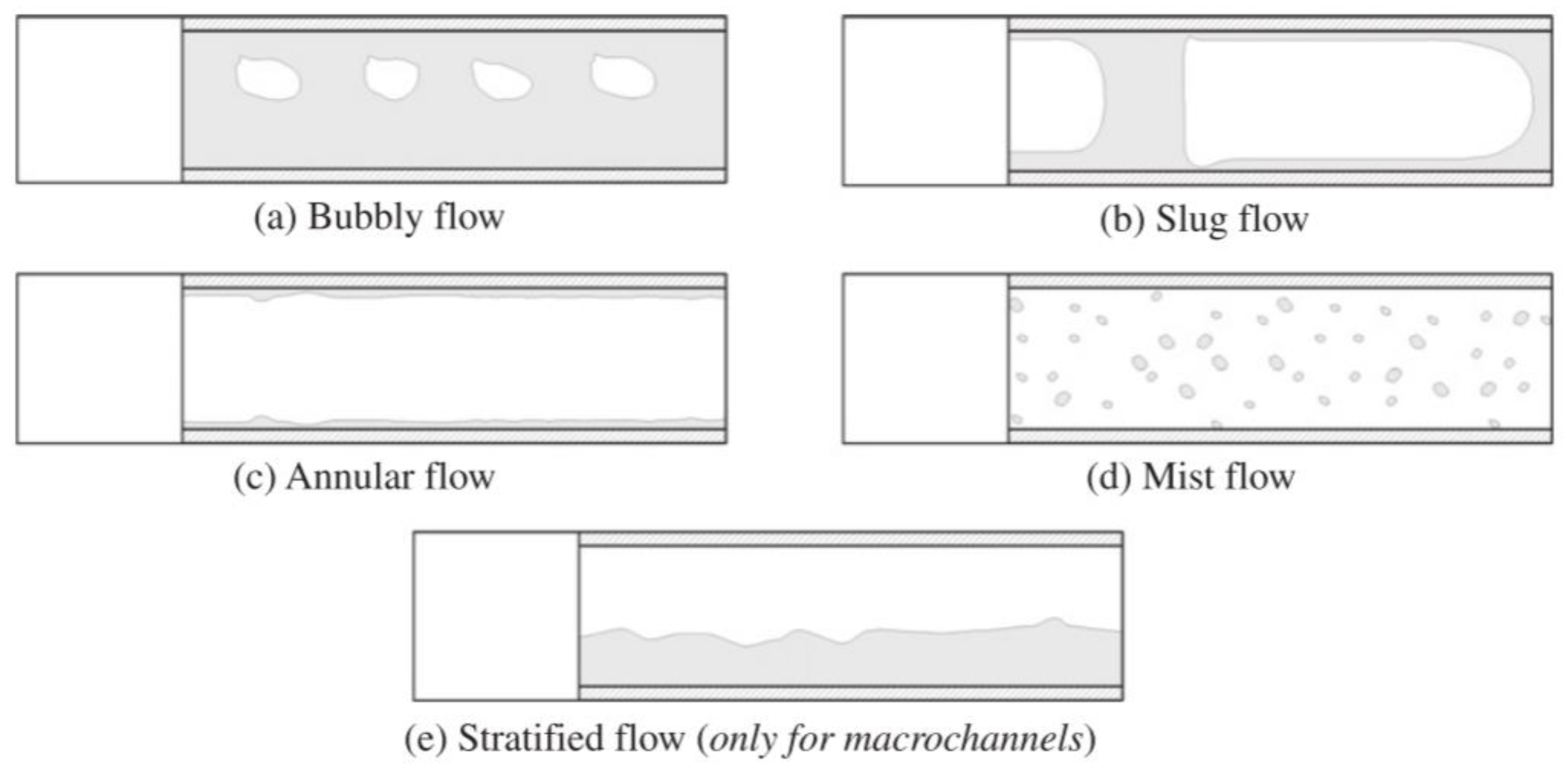
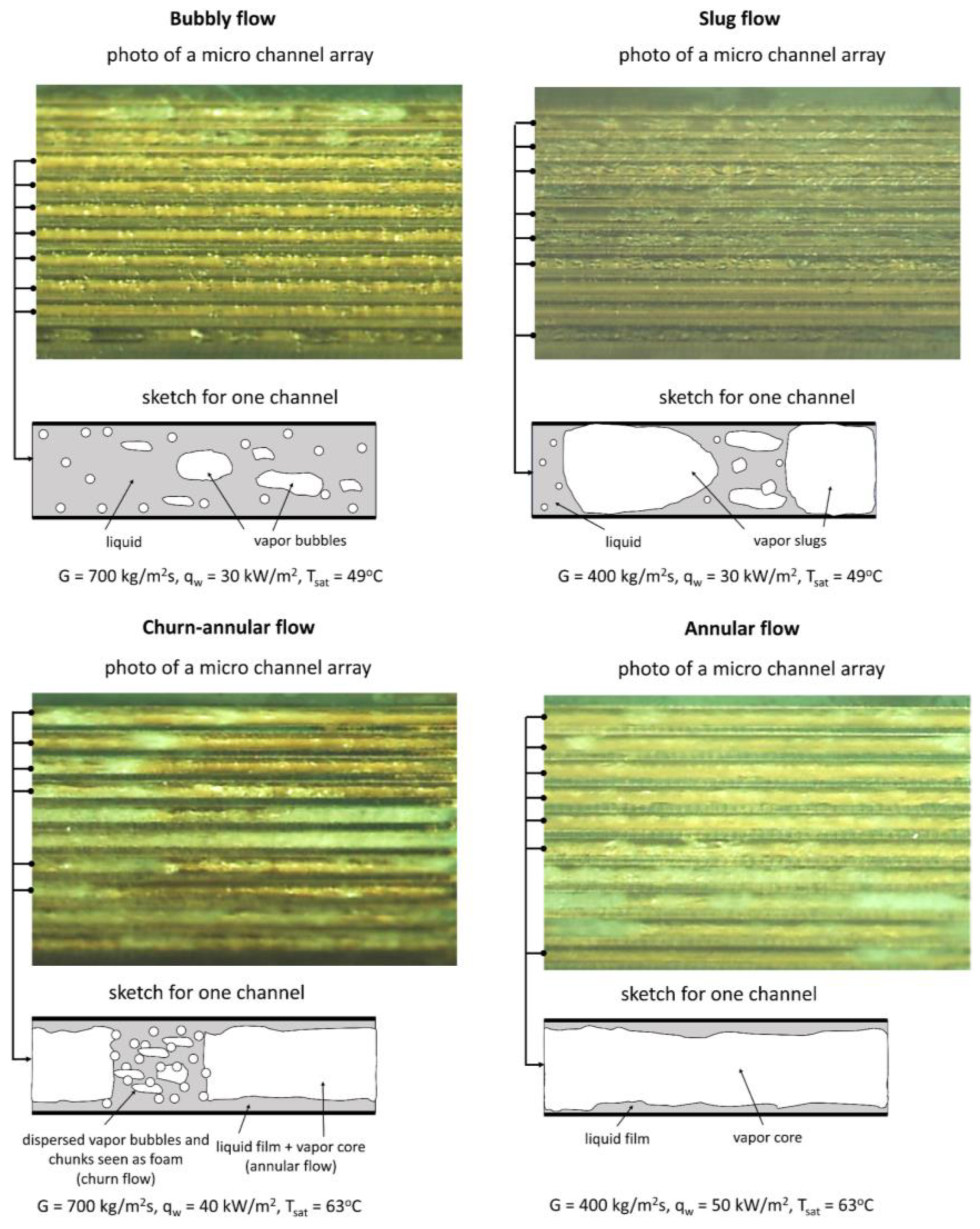

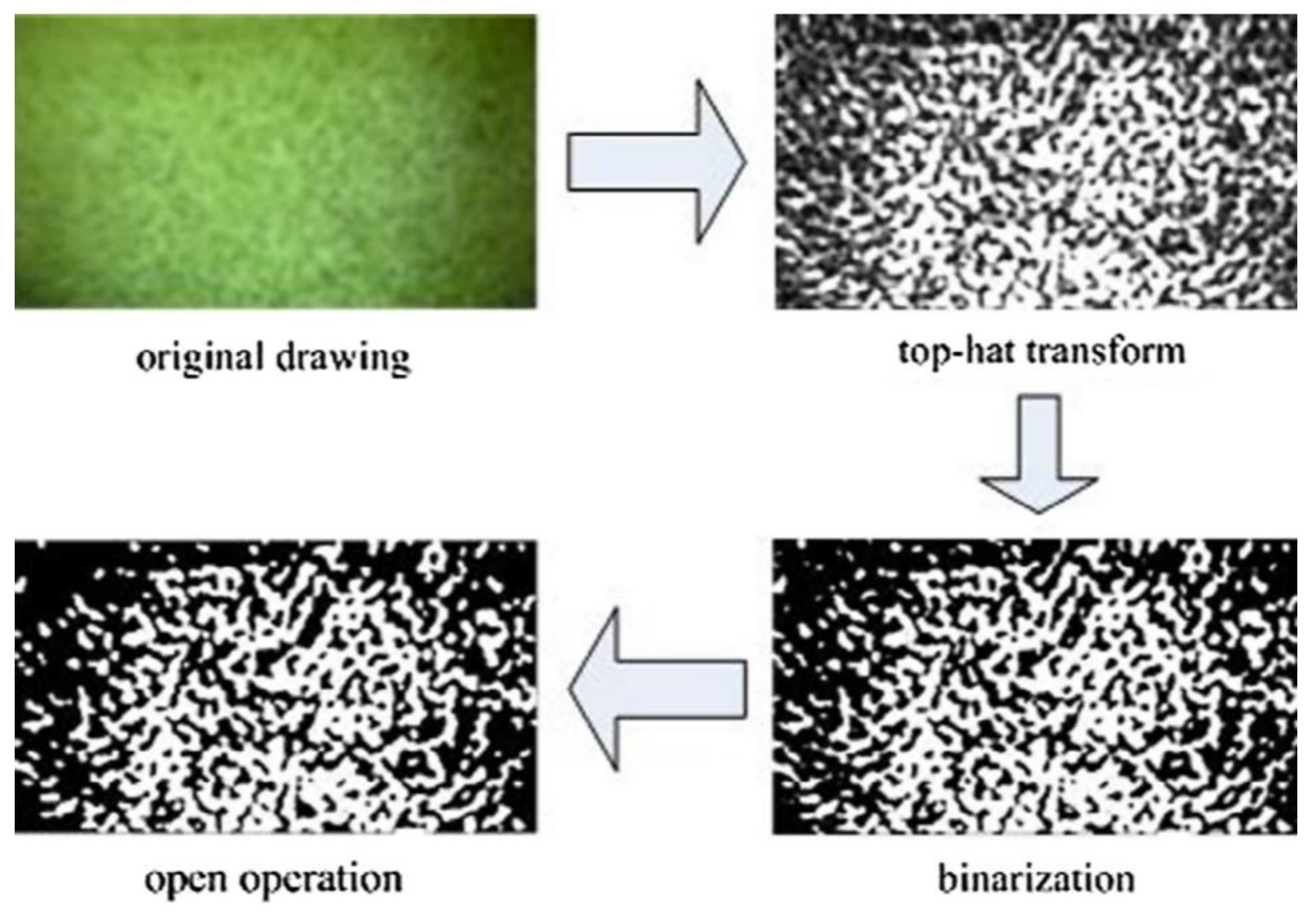
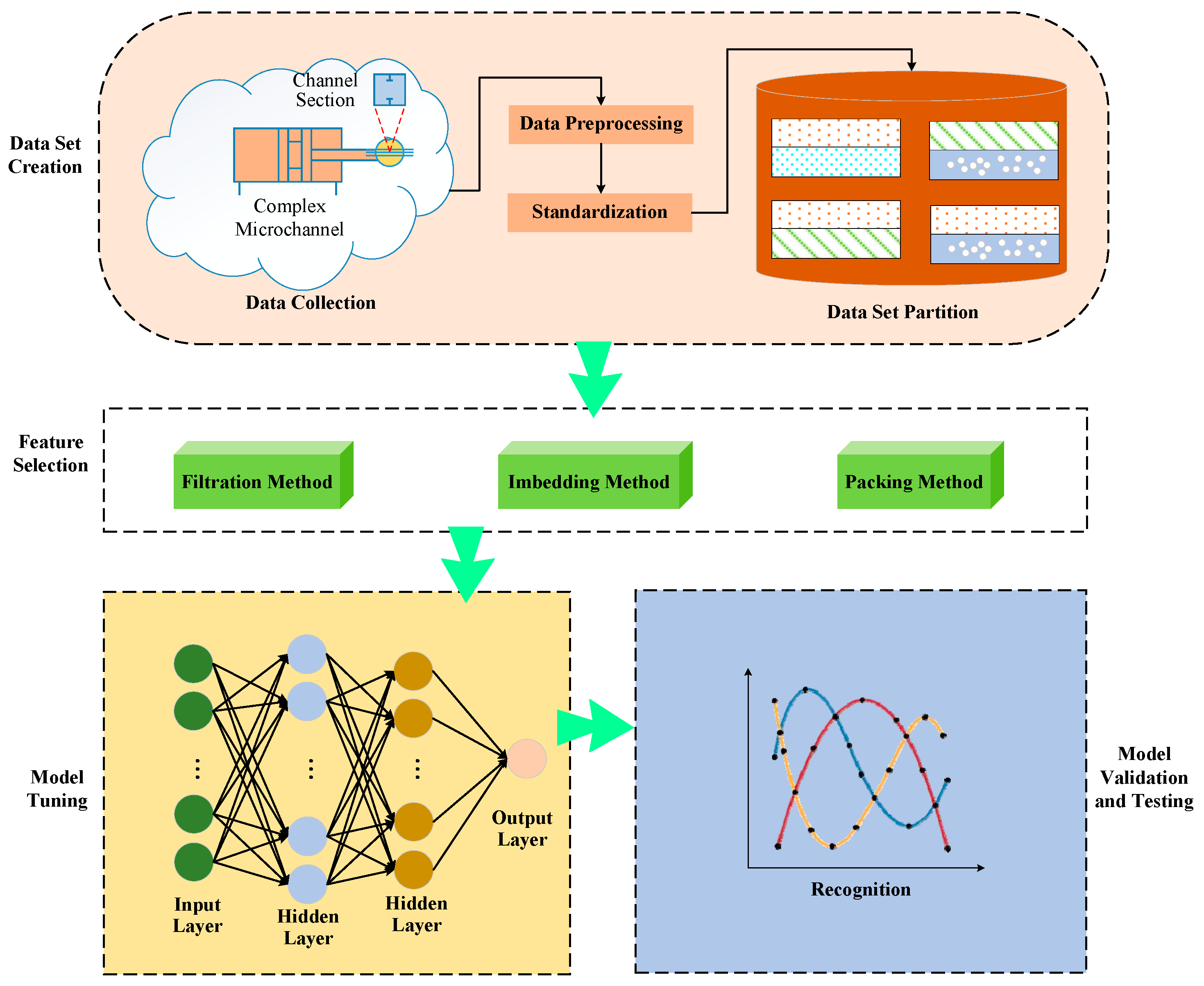

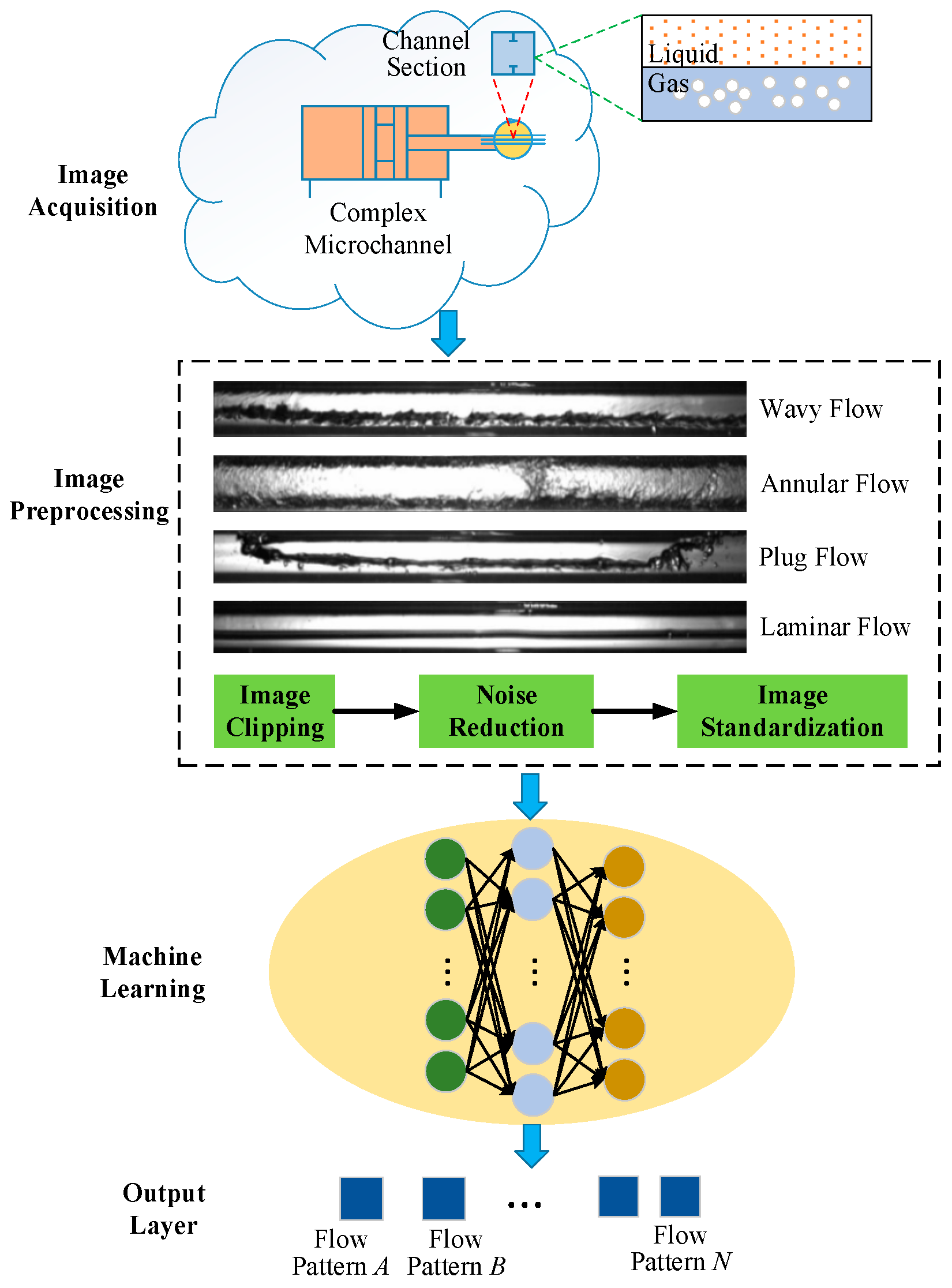
Disclaimer/Publisher’s Note: The statements, opinions and data contained in all publications are solely those of the individual author(s) and contributor(s) and not of MDPI and/or the editor(s). MDPI and/or the editor(s) disclaim responsibility for any injury to people or property resulting from any ideas, methods, instructions or products referred to in the content. |
© 2023 by the authors. Licensee MDPI, Basel, Switzerland. This article is an open access article distributed under the terms and conditions of the Creative Commons Attribution (CC BY) license (https://creativecommons.org/licenses/by/4.0/).
Share and Cite
Yang, B.; Zhu, X.; Wei, B.; Liu, M.; Li, Y.; Lv, Z.; Wang, F. Computer Vision and Machine Learning Methods for Heat Transfer and Fluid Flow in Complex Structural Microchannels: A Review. Energies 2023, 16, 1500. https://doi.org/10.3390/en16031500
Yang B, Zhu X, Wei B, Liu M, Li Y, Lv Z, Wang F. Computer Vision and Machine Learning Methods for Heat Transfer and Fluid Flow in Complex Structural Microchannels: A Review. Energies. 2023; 16(3):1500. https://doi.org/10.3390/en16031500
Chicago/Turabian StyleYang, Bin, Xin Zhu, Boan Wei, Minzhang Liu, Yifan Li, Zhihan Lv, and Faming Wang. 2023. "Computer Vision and Machine Learning Methods for Heat Transfer and Fluid Flow in Complex Structural Microchannels: A Review" Energies 16, no. 3: 1500. https://doi.org/10.3390/en16031500








